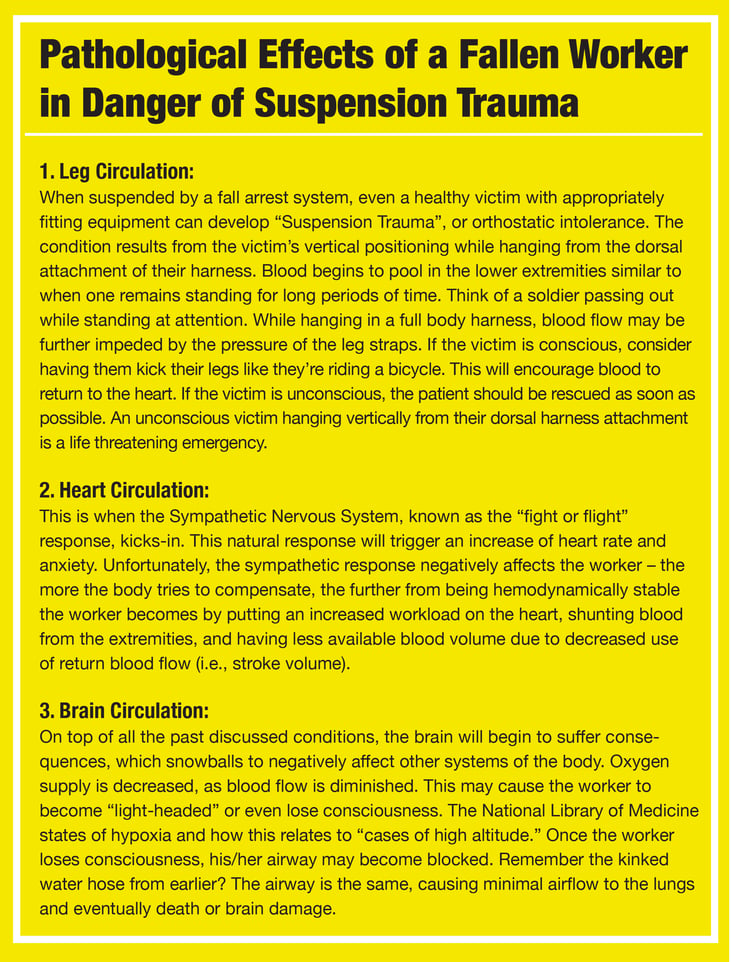Suspension Trauma: Roco Safety Poster
“ANSI Z359 as well as OSHA 1926.502(d)(20) require employers to provide the prompt rescue of employees in the event of a fall, or assure that employees are able to perform self-rescue.”
What is suspension trauma?
Suspension Trauma (also known as orthostatic intolerance) has been identified by OSHA as a workplace hazard for those using Personal Fall Arrest Systems (PFAS) who may be suspended from their harness for a period of time following a fall. More and more employers are becoming aware of this workplace hazard and are taking appropriate steps to protect their employees.
The range of understanding on the cause of suspension trauma, as well as how to protect against it, is limited – and it has been revised over the years to include updated information as shown here. The development of suspension trauma varies from individual to individual and its onset can be difficult to predict. However, it is important to be aware of the Suspension Trauma hazard and be prepared to take action as needed. Employers need to be aware that this syndrome is potentially life threatening.
Our revised Suspension Trauma Safety Poster is a tool to raise awareness of this potential hazard. It illustrates the pathological effects that a suspended worker may experience. We encourage you to share it with others who may work-at-height and/or use PFAS. Rescuers also need to be aware of this information and precautionary measures. Roco offers Rescue from Fall Protection training to educate rescuers who may respond to suspended workers.
Briefly, we will review the signs and symptoms of suspension trauma as well as factors that can influence the onset. We will also mention several options to prevent its occurrence as well as what precautions to take in treatment for suspension trauma. Suspended workers with head injuries or who are unconscious are particularly at risk (according to OSHA Bulletin 03-24-2004, updated 2011). As always, it is very important to follow your local treatment protocols.
What are signs and symptoms of suspension trauma?
Common signs and symptoms include light-headedness, heart palpitations, trembling, fatigue, nausea, dizziness, headache, sweating, weakness or fainting. Factors that influence the potential for suspension trauma as well as the speed of onset include the following:
- Unconsciousness, fainting or immobility;
- Underlying physical conditions including any pre-existing respiratory or cardiac conditions;
- Worker’s ability to handle stress and anxiety;
- Harness selection, fit, and adjustment;
- Traumatic injuries that may have occurred during or before the fall; and,
- Knowledge and the use of equipment or techniques to delay the onset of suspension trauma such as temporary leg stirrups or simply “bicycling the legs.”
What can be done to prevent suspension trauma?
- Follow manufacturer guidelines on harness use and proper fit.
- Preparation of a Fall Hazard Assessment, including a plan for self-rescue or assisted rescue as needed.
- Leg movement or bicycling of the legs while suspended.
- Use of a “step-up” device to relieve pressure. Example: MSA makes a device that attaches to the harness to help take pressure off the legs. (MSA Suspension Trauma Safety Step)
- Timely availability of a properly trained rescue service, such as an in-house team or a contracted rescue team prepared for suspended worker rescue.
What are the latest treatment opinions?
The following information is from “Evidence-Based Versus Myth-Based Treatment of Suspension Syndrome” by Roger B. Mortimer, MD and Ken Zafren, MD, published May 30, 2020.
For many years, the theory has been that a worker with the potential of suspension trauma should be placed in a certain position for a certain amount of time following rescue. The theory was that if a worker remained standing or sitting, the toxic blood would be introduced back into central blood flow, at a lower rate, minimizing risk of cardiac arrest – similar to a tourniquet being released too quickly on an extremity, so the right side of the heart would not be overloaded.
However, this theory hasn’t proven entirely true. According to the referenced article, the worker should not be treated any differently than any other patient that presents with signs and symptoms of shock. Simply put, if the patient is displaying “shock-like” symptoms, assess and manage the patient’s airway, breathing, and circulation. Place the patient in the supine position (flat on back), and rapidly transport to the nearest hospital with adequate services.
Notice: It is always important to follow local treatment protocols.
In summary
Suspension trauma is a hazard to be considered (and prepared for) by employers with workers using PFAS. A worker suspended from their fall protection harness must be treated and rescued in a very timely manner – or be prepared for self-rescue when viable. The use of a Fall Hazard Survey is highly recommended – as well as the preparation of a Rescue from Fall Protection Rescue Preplan (samples referenced below). Rescue personnel must also be trained, prepared and equipped for Rescue from Fall Protection operations.






